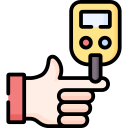Continuous Subcutaneous Insulin Infusion (CSII) or insulin pump therapy is administered via a battery driven pump.
Rapid acting insulin (e.g. Novorapid, Humalog, Fiasp or Lyumjev) is delivered by pump via an infusion set which is inserted into the subcutaneous tissue. This can either be a pump that is then connected via tubing to a cannula insertion site or a ‘tubeless’ infusion set. With some pumps the settings are adjusted through the pump attached to the infusion set, with others the infusion set connects wirelessly to a ‘personal diabetes manager (PDM)’ that looks similar to a mobile phone. Pictorial examples can be found at https://abcd.care/dtn/virtual-showroom
The infusion set needs changing every 2-3 days.
Regular blood glucose and ketone monitoring is essential to guide with insulin dosing.
Insulin pumps should not be immersed in water.
Patients will need to bring supplies for the pump, including infusion sets, insulin reservoirs, insulin vials and batteries with them into hospital.
Pumps can act in 2 modes:
1: Manual
The background (basal) rate at which the insulin is pumped can be pre-programmed to provide a number of different rates across a 24 hour period. These can be adjusted in response to current needs, e.g. during fasting, excercise, illness.
Bolus insulin doses are calculated according to carbohydrate food intake (e.g. 1 unit per 10g CHO), taking into account any correction dose that may be additionally required, and administered by pressing a button on the pump.
Patients are trained on how to change the settings
2: Hybrid closed-loop
The patient will have both a pump and a continuous glucose monitoring sensor. The sensor communicates regularly with the pump and the pump uses an algorithm to adjust the basal (background) rate of insulin administration to aim for glucose within a pre-defined target. Target glucose and the algorithm can be adjusted.
Bolus insulin doses are calculated according to carbohydrate food intake (e.g. 1 unit per 10g CHO) and administered by pressing a button on the pump.
Some pumps can switch between modes and some only offer one mode.
